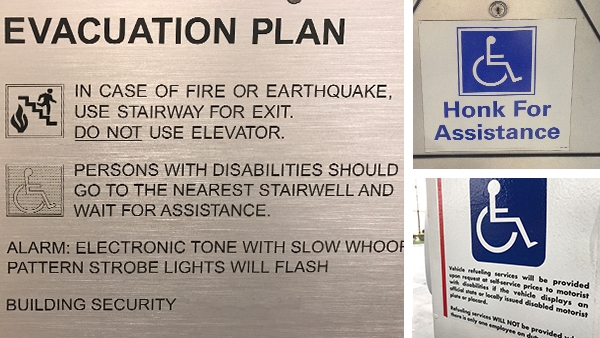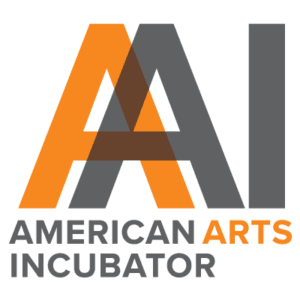Research
As a designer, I look towards my environment and observations of the people around me as sources of inspiration and intrigue. In observing, watching and looking for threads of disability throughout my travels and in daily reoccurance, I have become acutely aware of how spaces are inhabited by invisible and visible bodies.
It’s interesting to consider how much people with disabilities have to “honk”, “wait” and “display” themselves in public to be noticed and assisted. In terms of wayfinding and navigating the public environment (as show in the images above on the left, a building, and on the right, gas stations), navigating the environment is seen as a very independent process in America. In order to “evacuate” or “have gas pumped”, someone with disabilities might require assistance. So importance is placed on one’s need to proclaim disability, as seen through the “wheelchair” sign or display placards on cards.
When I traveled to Hong Kong and used their subway system, a curious little device caught my ear…
Here, a melody of tones play to help the user locate the device. The interface is fitted with braille and raised surfaces to map out the subway through tactile forms. It uses the senses of audio and touch to communicate information with the user. The subway is an especially busy place in Hong Kong, where people walk more and use public transportation. With special devices installed for the blind, people with disabilities can navigate the subway stations and walk around to get from place to place.
Looking at design can give great inspiration to an artist. How can design influence art and artistic expression? The functional and utilitarian ways of navigating space with a disability provides an interesting perspective on how one lives with disability, often dependent on available tools in public environments to maintain relative independence. What is interesting is how culture plays such a large role: shaping how visible or invisible a disability is, how much independence is given to the user, even how the users feel during the interaction. Oftentimes, the interaction is a very visible experience where one is labeled with the identity of the disability as understood by other people. Navigating public spaces then requires a certain degree of social vulnerability and visibility at the same time.
Play
So what about the influence of disability in spaces of play or expression? The example of the tactile interface with the friendly melody coaxes the user towards the wayfinding station, adding personality and charm to the experience. I’m reminded of spaces like festivals or theme parks where recreational immersive experiences become spaces of play and imagination. What would it mean to play and “share space” in ways that go beyond languages and abilities?
Navigating such environments, as shown here at the TomorrowWorld festival, an attendee and her deaf friend are there enjoying the music, which can be interpreted and appreciated in a number of ways that exceed the sense of sound. The feeling of the bass, emotional meanings, sights and elements presented in the whole experience create an immersion in sensory experiences and meanings. There is also the sense of inclusion evoked by them dancing and enjoying the moment together. Imagine what might be possible if new kinds of sensory tools were developed that could interpret our reality in shared spaces to allow for inclusive interactions.
Wearables
The influences technology has had for people with disabilities is far reaching. Take for example, the hearing aid, where its influence can be felt in the design of headphones and earbuds with ever increasing need for smart technology, like wireless communication. With the popularity of audiophiles and our audio-visual culture, we are surrounded by exciting examples where disability inspires expression, like in the sense of hearing and sight. Here we are still looking at the framing of disability through the loss of sense and amplifying it through electronics. The hearing aid’s functionality and purpose are to amplify the surrounding environment, while headphones enable users to switch to a completely different digital or analog environment. The headphones add a layer of expression and emotion on top of our existing environment. Design and artistic expression can tackle situations in new ways that can bridge both physical and mental disabilities.

Over the next few weeks, I will begin to explore how accessibility and sensitivity can be designed into our environments and experiences. I’m excited to explore such possible avenues that wearable technology can have both in America and in the streets of Moscow. Looking at disabilities inclusion through the lens of an arts exchange such as AAI, the emerging influence of wearable technology in the West can find new inspiration within the rich visual art and culture found in Russia. Beginning to explore socially engaged art through emerging sensors and wearables can begin to break down barriers and promote inclusion through new kinds of social, and possibly sensory, interactions.

